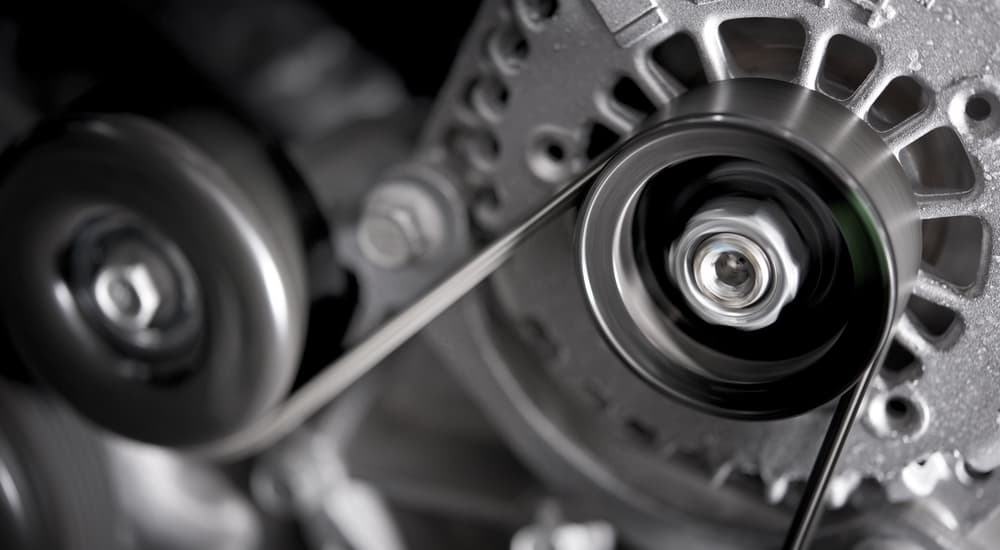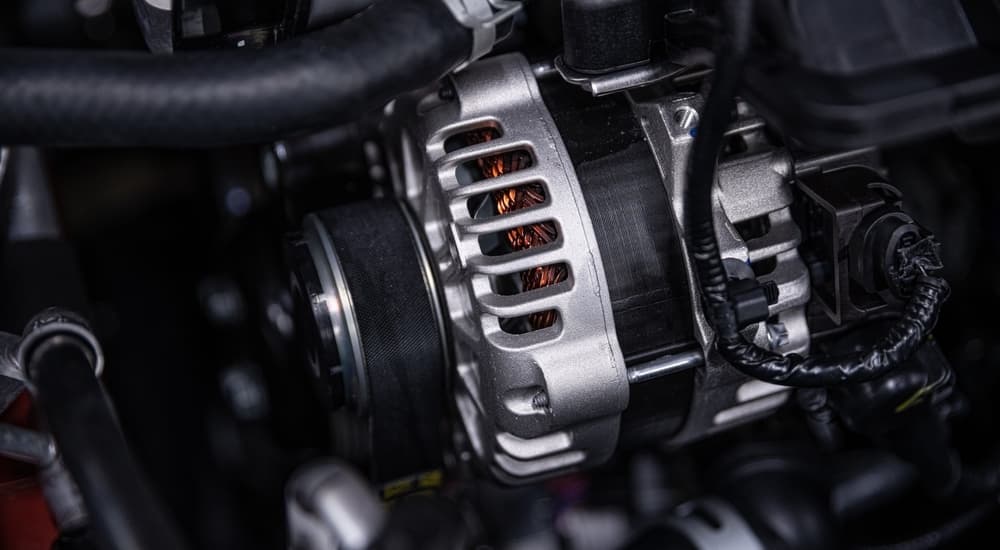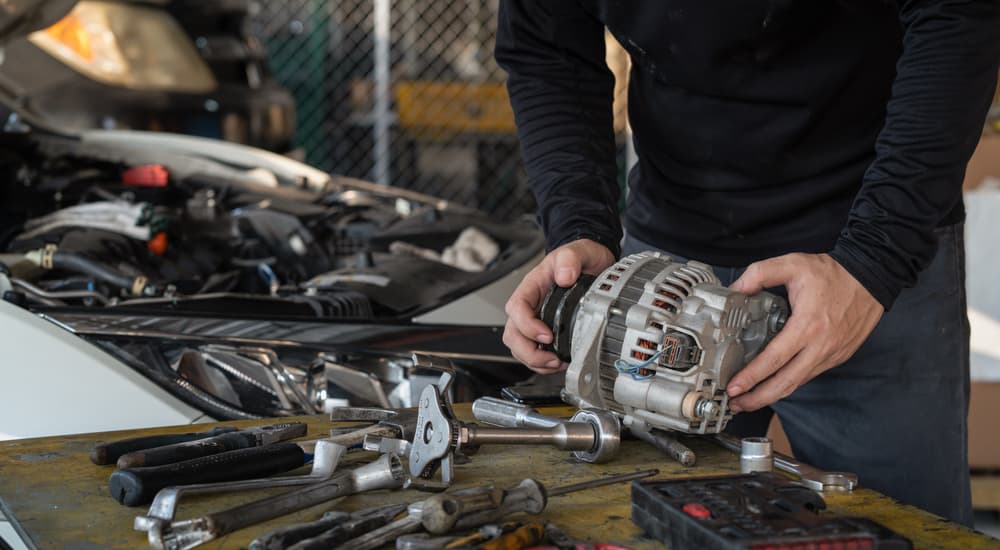Pop the hood. If you’ve heard that phrase before, and you probably have, then you know your hands are about to get dirty. Under the hood, you’ll find a small, compact machine that resembles a miniature generator. This is called the alternator and supplies electricity to the car battery. It helps the vehicle function and is one of the most crucial parts that makes your car run. Think of it as the heart of the car; it supplies electricity to vital parts that give these machines life. However, sometimes, an alternator can experience a serious blood clot––in other words, it is no longer supplying electricity, which will leave you stranded on the side of the road. Here are the signs and a short guide to alternator problems to help you determine if you need an alternator replacement.
Diagnosing a Bad Alternator
If you have a bad alternator or an alternator with one foot in the grave, the first issue you’ll likely notice is the lights on your car. They can either get very dim or very bright. A dying alternator may provide too little or too much electricity to your car’s accessories, including the headlights. This change can be erratic, causing irritation when driving or a distraction while you’re on the road. It can also be mistaken or misdiagnosed as a battery problem, and while that is partly true (because your battery is not storing electricity), it is not your battery’s fault––your alternator is the culprit.
This can also result in accessories not working or running at a very… slow… irritatingly… time… wasting… pace. Signs of this could include slowness or a lack of power when you’re rolling up or down your windows, trying to use the radio, or turning on the air conditioning to cool off from the sweltering heat. Don’t feel those seat warmers kicking in yet? It could be part of an alternator issue. This will eventually result in nothing working if you do not take the problem seriously, which will also result in the next sign your alternator is bad….
Your car has stopped working. Yep, don’t address a failing alternator in time, and you may find yourself rolling to a stop or being unable to make it home after a long day of work because you have a bad alternator that resulted in a dead battery. If you’re constantly having to recharge or replace your car’s battery, then this is most likely not a battery issue––it’s your alternator!
Listen to your gut and listen to your car. If you’re looking to discover what is wrong with your car, you’ll likely notice some changes in how it sounds. But don’t worry, we don’t expect you to try to mimic the noise for the technicians. Just tell them what kind of noise you have been hearing. Noises that can be described as high-pitched whining or growls could be a result of the alternator’s belt coming loose. Another sense you can rely on is smell. If it smells like smoke or something is burning (particularly rubber), then you’ll probably want to get your car into the shop ASAP. This is caused by overheating, which can be very harmful to your vehicle and extremely unsafe, so take notice of your car’s sounds and smells.
One on-the-nose sign that you have a bad alternator is when you go to start your car, whether that is pushing the start button or turning the key, and nothing happens—your car won’t start. You may hear clicking sounds when you try to start your car, yet no life purrs through the engine. It has happened to the best of us. This is usually caused by a battery that is low on juice, which could be the result of a bad alternator. Make sure to get your car checked so it doesn’t leave you stranded again because jumping the battery won’t necessarily fix the issue.
Last but not least, there are the warning lights that may appear on your dash. You know, typically the orange ones that resemble an engine or battery outline? Yeah, you know the one. In fact, we all do. You may believe that these lights indicate something is amiss with your engine or battery. However, this is not always the case. In fact, it can indicate issues that affect their performance, such as a bad alternator. If you need another sign that you may have a bad alternator, then keep an eye on the dash.
What Is a Typical Alternator Lifespan, and When to Replace it?
Why do alternators go bad or suddenly create an issue where you constantly have to get your battery charged? The thing about these integral parts is that, like the battery, tires, and air filters, the alternator also has a lifespan and will need to eventually be replaced if you plan to own your car for a long time. The good news is that you can expect your alternator to last around 80,000 to 150,000 miles. Further, alternators are easily replaceable, so you can continue driving your car for years to come, even if the alternator starts going bad and needs to be replaced.
You may be asking yourself, how do you replace an alternator? The easy answer is to take your car to the service center and have professional technicians handle it for you. However, for the moms and pops out there who are searching for their next DIY project, we’re here to tell you it’s not so bad. You can save yourself some money by doing it yourself if you have the tools and some mechanical know-how! If you have a few hours on your hands, then it is possible to take out the old alternator and install a new one.
The alternator is usually relatively accessible and mounted on the front or side of the engine. However, you will have to remove some belts and possibly some other parts to get it out. Before you try to replace it yourself, make sure that the alternator is, in fact, causing you issues. You will most likely want to have this checked by a professional, as it requires some special tools and knowledge. You will know if you’re prepared to change your alternator on your own if you have some experience working on cars or if you’re able to follow instructions and are familiar with the tools required.
Know the Signs of a Bad Alternator
Don’t worry; changing an alternator is a common occurrence when you have a higher-mileage car. It is important to know the signs of when your alternator is beginning to wear out. Being able to identify what is going wrong can make things easier for you and allow you to spend less time at the service center figuring out what exactly is wrong. Keep in mind these few tips and tricks to diagnose a bad alternator, and remember that you will likely have an alternator go bad at some point––unless you plan to keep buying new cars or used cars with low mileage. Of course, the newer car you have with fewer miles, the less you’ll need to be wary. Drive safe, and good luck!






